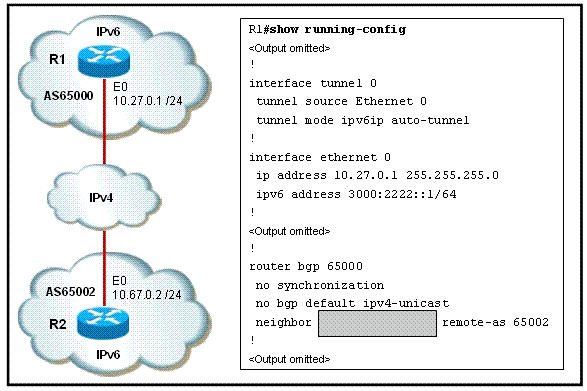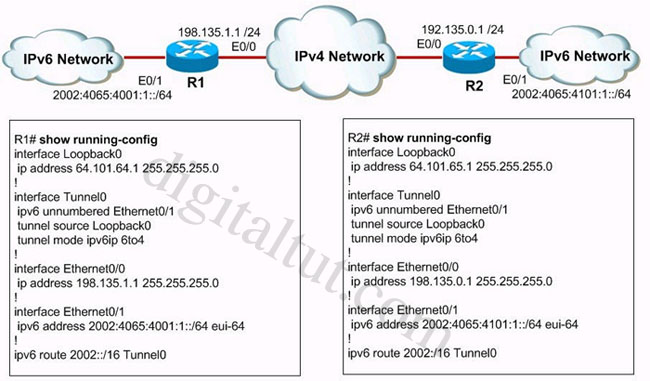IPv6 Questions
Here you will find answers to IPv6 questions
If you are not sure about IPv6, please read my IPv6 tutorial
Question 1
Which two reductions are the correct reductions of the IPv6 address 2001:0d02:0000:0000:0014:0000:0000:0095? (Choose two)
A – 2001:0d02:::0014:::0095
B – 2001:d02::14::95
C – 2001:d02:0:0:14::95
D – 2001:d02::14:0:0:95
Answer: C D
Explanation
A is not correct because we can’t use triple colons (:::) in IPv6 presentation. B is not correct because we can’t use double colons (::) twice. You can use it only once in any address because if two double colons are
placed in the same address, there will be no way to identify the size of each block of 0s. Remember the following techniques to shorten an IPv6 address:
– Omit leading 0s in the address field, so :0000 can be compressed to just :0 and :0d02 can be com-
pressed to :d02 (but :1d00 can not be compressed to :1d)
– Use double colons (::), but just once, to represent a contiguous block of 0s, so 2001:0d02:0000:0000:0014:0000:0000:0095 can be compressed to 2001:0d02::14:0:0:95 or 2001:0d02:0:0:14::95
Question 2
What is the IPv6 address FF02::2 used for?
A – all hosts in a local segment
B – all routers in a local segment
C – all hosts in a particular rnulticast group
D – all routers in an autonomous system
Answer: B
Explanation
Below lists some reserved and well-known IPv6 multicast address in the reserved multicast address range (FF00:: to FF0F::)
| Multicast Address | Multicast Group |
| FF01::1 | All IPv6 nodes within the node-local scope |
| FF01::2 | All IPv6 routers within the node-local scope |
| FF02::1 | All IPv6 nodes within the link-local scope |
| FF02::2 | All IPv6 routers within the link-local scope |
| FF02::5 | All OSPFv3 routers within the link-local scope |
| FF02::6 | All OSPFv3 designated routers within the link-local scope |
| FF02::9 | All RIPng routers within the link-local scope |
| FF02::A | All EIGRP routers within the link-local scope |
| FF02::D | All PIM routers within the link-local scope |
| FF02::1:2 | All DHCPv6 agents (servers and relays) within the link-local scope |
| FF05::2 | All IPv6 routers within the site-local scope |
| FF02::1:FF00:0/104 | IPv6 solicited-node multicast address within the link-local scope |
Question 3
Refer to the exhibit. Routers R1 and R2 are IPv6 BGP peers that have been configured to support a neighbor relationship over an IPv4 internetwork. Which three neighbor IP addresses are valid choices to use in the highlighted section of the exhibit? (Choose three)

A – ::0A43:0002
B – 0A43:0002::
C – ::10.67.0.2
D – 10.67.0.2::
E – 0:0:0:0:0:0:10.67.0.2
F – 10.67.0.2:0:0:0:0:0:0
Answer: A C E
Explanation
The automatic tunneling mechanism uses a special type of IPv6 address, termed an “IPv4-compatible” address. An IPv4-compatible address is identified by an all-zeros 96-bit prefix, and holds an IPv4 address in the low-order 32-bits. IPv4-compatible addresses are structured as follows:

Therefore, an IPv4 address of 10.67.0.2 will be written as ::10.67.0.2 or 0:0:0:0:0:0:10.67.0.2 or ::0A43:0002 (with 10[decimal] = 0A[hexa] ; 67[decimal] = 43[hexa] ; 0[hexa] = 0[decimal] ; 2[hexa] = 2[decimal])
Question 4
Refer to the exhibit. The 6to4 overlay tunnel configuration has been applied on each router to join isolated IPv6 networks over a IPv4 network. Which statements regarding the 6to4 overlay tunnel is true?

A -The least significant 32 bits in the address referenced by the ipv6 route 2002::/16 Tunnel0 command will correspond to the interface E0/0 IPv4 address
B – The least significant 32 bits in the address referenced by the ipv6 route 2002::/16 Tunnel0 command will correspond to the IPv4 address assigned to the tunnel source
C – The configuration is invalid since the tunnel source command must be configured with an IPv6 address
D – This is actually a configuration example of an IPv4-compatible tunnel and not a 6to4 tunnel
E – This is actually a configuration example of an ISATAP overlay tunnel and not a 6to4 tunnel
Answer: B
Explanation
6to4 tunnels use IPv6 addresses that concatenate 2002::/16 with the 32-bit IPv4 address of the edge router, creating a 48-bit prefix. The tunnel interface on R1 has an IPv6 prefix of 2002:4065:4001:1::/64, where 4065:4001 is the hexadecimal equivalent of 64.101.64.1, the IPv4 address of its interface in the IPv4 network. The tunnel interface on R2 has an IPv6 prefix of 2002:4065:4101:1::/64, where 4065:4101 is the hexadecimal equivalent of 64.101.65.1, the IPv4 address of its interface in the IPv4 network.
When R1 receives a packet with IPv6 destination address of 2002:4065:4101:1:: (from the left IPv6 network, for example) R1 will:
* Take the IPv6 destination address of that packet (2002:4065:4101:1::) and convert it into an IPv4 address. In this case, the IPv4 address is 40.65.41.01 in hexa, which is 64.101.65.1 in decimal format.
* R1 encapsulates the IPv6 packet in an IPv4 packet with a destination address of 64.101.65.1; the packet is routed normally through the IPv4 network to R2
* R2 receives the IPv4 packet, decapsulates and routes it normally to its final IPv6 destination.
Question 5
What will occur when an IPv6 enabled router running 6to4 must transmit a packet to a remote destination and the next hop is the address of 2002::/16 ?
A – The IPv6 packet has its header removed and replaced with an IPv4 header
B – The IPv6 packet is encapsulated in an IPv4 packet using an IPv4 protocol type of 41
C – The IPv6 packet is dropped because that destination is unable to route IPv6 packets
D – The packet is tagged with an IPv6 header and the IPv6 prefix is included
Answer: B
Question 6
What are three IPv6 transition mechanisms? (Choose three)
A – 6to4 tunneling
B – VPN tunneling
C – GRE tunneling
D – ISATAP tunneling
E – PPP tunneling
F – Teredo tunneling
Answer: A D F
Explanation
Below is a summary of IPv6 transition technologies:
6 to 4 tunneling: This mechanism allows IPv6 sites to communicate with each other over the IPv4 network without explicit tunnel setup. The main advantage of this technology is that it requires no end-node reconfiguration and minimal router configuration but it is not intended as a permanent solution.
ISATAP tunneling (Intra-Site Automatic Tunnel Addressing Protocol): is a mechanism for transmitting IPv6 packets over IPv4 network. The word “automatic” means that once an ISATAP server/router has been set up, only the clients must be configured to connect to it.
Teredo tunneling: This mechanism tunnels IPv6 datagrams within IPv4 UDP datagrams, allowing private IPv4 address and IPv4 NAT traversal to be used.
In fact, GRE tunneling is also a IPv6 transition mechanism but is not mentioned in ROUTE so we shouldn’t choose it (there are 4 types of IPv6 transition mechanisms mentioned in ROUTE; they are: manual, 6-to-4, Teredo and ISATAP).


